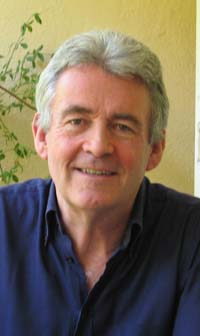
|
THE GESTATION OF MENDEL'S DWARFDown a wide street from the top of the town, down past grimy frontages and shops that are only just waking up to the full commercial life of the 20th century, down past the city hospital and the traffic lights, you finally reach the square with the streetcar terminus. The city fathers have named the square after him, although right up until the end of the 1960s his ideas were banned inside the Soviet bloc. Mendlovo námestí, Mendelplatz, Mendel Square it is called. Pilgrimage? Certainly a faint air of reverence surrounds the memory of the priest who founded the science of genetics. There is the monastery to visit; there is a display of relics to gaze on in the museum -- a microscope, a telescope, a pair of steel-rimmed glasses, a manuscript written in impeccable copperplate; and in the garden there is even a statue of him holding out his arms as though to bestow his blessing on the whole world. When I was there someone had laid a bunch of wild flowers at the foot of the monument as an offering to the saint. But the pilgrimage to Gregor Mendel's home is a secular one: the visitors' book in the museum is filled with names from research institutes and universities around the world, and as I added my own I felt bound to qualify it in some way: "biologist," I wrote. Gregor Mendel is the archetype of the scientist whose ideas are ahead of his time. His work with the garden pea, culminating in the brilliant paper of 1866, "Versuche über Pflanzenhybriden" ("Experiment in Plant Hybridization"), wasn't just ignored by the academic world -- it simply wasn't understood. It was a 20th-century research program with a wholly modern sense of focus and clarity, a revolutionary understanding of the need for controls and replicates, and a startling mathematical analysis of the kind that before then had only ever applied to physics. But it was all carried out in the middle of the 19th century. Is it surprising that Mendel's contemporaries failed to come to terms with a man who had spent eight years growing more than 30,000 pea plants, all the time counting, counting, counting, before finally describing his findings in terms of a binomial expansion? This disjunction between the man and his epoch is one reason why his work has always fascinated, but Mendel's legacy has many codicils. In the museum at the monastery the final exhibit explains the contribution that the University of Brno is making to the Human Genome Project. The science that Mendel unwittingly founded is concerned with the future -- our future, the future of mankind. So the novel that was gestating within me would have to be concerned with modern genetics as well as with the life of Gregor Mendel. Part of the language of the novel would be the language of science itself, the curious dialect of scientific papers, with their footnotes and their references. And as the whole business of genetics is a lottery, so there would also be the taunting, mocking language of chance, of odds, of betting. But, above all, the voice of the novel had to be that of someone who lives in the full consciousness of his genetic make-up, someone with a genetic problem that would rule his life. Achondroplasia, the most common form of dwarfism, occurred to me for an entirely practical reason: it is unequivocal, a simple dominant Mendelian condition with 100 percent penetrance. That is, if you have the gene, then you will be certain to have the phenotypic condition in its fully developed form. But there was also a personal interest: long ago I had a close friend, a remarkable and brave woman, who suffered from achondroplasia. Thus I knew something -- only a little -- of what such a genetic heritage might mean. And further, the novel would be about choice, because the powerful and simple fact of genetics is that you have no choice. My friend had no choice, the sufferer from Huntington's disease or cystic fibrosis has no choice, just as you, the reader -- I presume on no evidence whatever, healthy, intelligent,and normal -- have no choice. The matter of inheritance has never been about choice ... until today. For Mendel's legacy has many codicils, and nowadays it is possible to defeat the odds. As I began to research the book, and as my dwarf protagonist made his first acerbic observations on life, I learned that reality was catching up with me: the gene for achondroplasia had just been located on the short arm of chromosome 4, and the precise detail of the mutation revealed. It is a point mutation in the gene coding for fibroblast growth factor receptor 3, and, unusually, it was identical in every case investigated. Furthermore, the mutation creates a new site for a restriction enzyme, and thus provides an instant, easy method of prenatal screening. One takes that kind of thing as an omen, a nod from the god of chance that you have got it about right. My character Benedict Lambert would be a molecular biologist. He would search for the gene that caused his condition, and he would be able to use his discoveries to usurp the tyranny of chance. He would attempt to command the next roll of the dice. He would epitomize the fall from grace of modern biology.Through his tortured relationship with the woman who is carrying his child, he would try to play God. Copyright © Simon Mawer 1998
|
|
